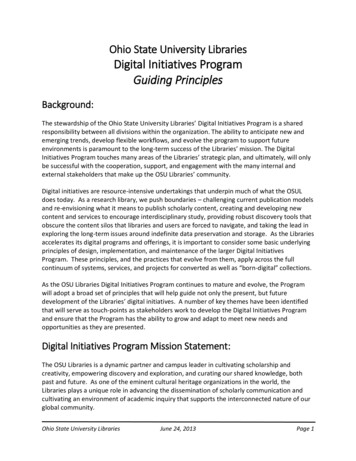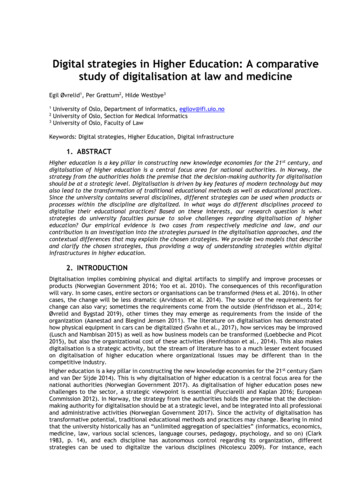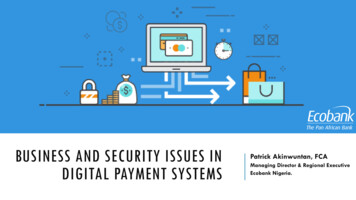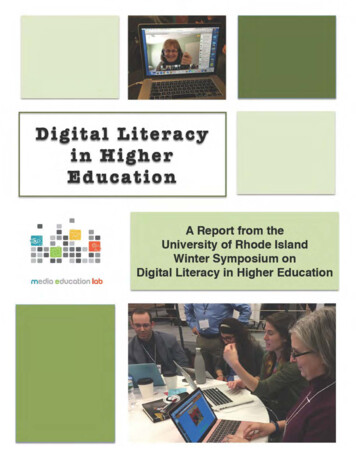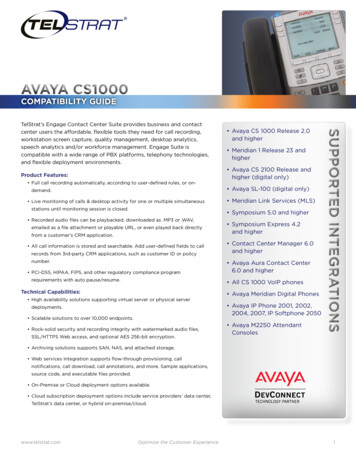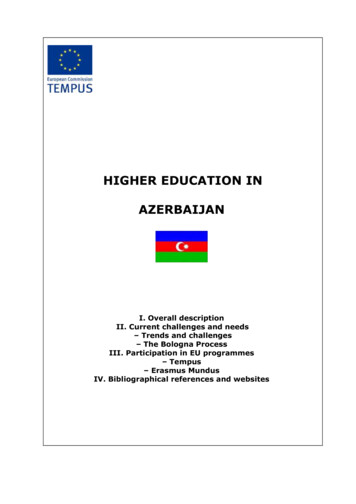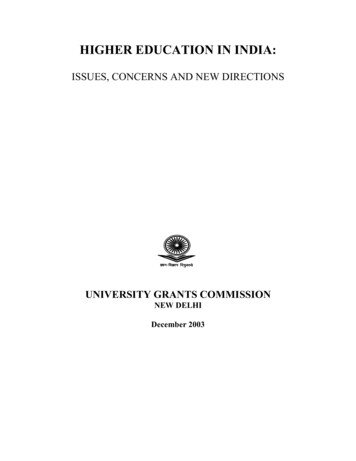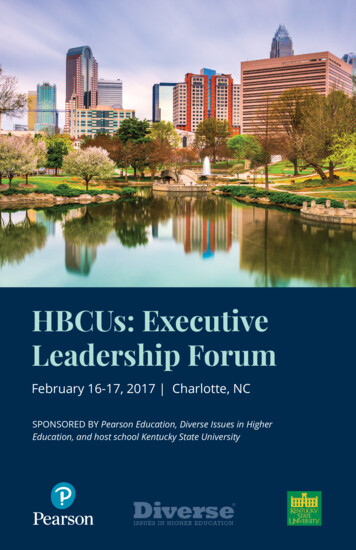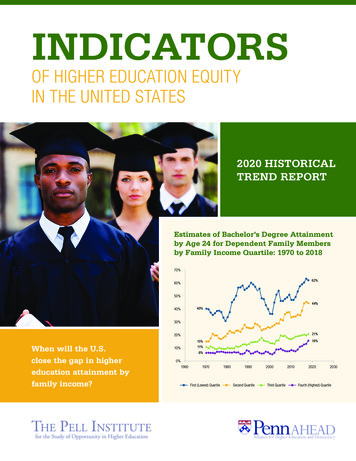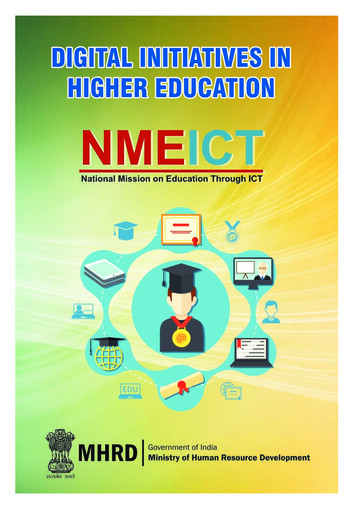
Transcription
DIGITAL INITIATIVES IN HIGHER EDUCATIONMinistry of Human ResourceDevelopmentDepartment of Higher EducationGovernment of IndiaForewordThe quality and access to higher education has been a subject of intense concern to allof us. The advancements in digital technologies are transforming the way educationalresources are being created, disseminated and accessed across the world. Use of digitaltechnologies in all aspects of higher education has also received a major push in India. Thisin turn helps the quality improvement & accessibility of Higher Education to large partof students as well as up-skilling of the teachers across the country. Digital technologieshave also greatly impacted the management and governance of the institutions as wellas the accreditation and ranking of the Higher Education Institutions (HEIs).Department of Higher Education, Ministry of Human Resource Development, hasundertaken many initiatives for exploiting the digital technologies in improving thequality & accessibility in Higher Education as well as better tools for accreditation andgrading of educational institutions.)LQDOO\ PDQ\ QHZ IURQWOLQH WHFKQRORJLHV OLNH UWLÀFLDO ,QWHOOLJHQFH 0DFKLQH /HDUQLQJ Autonomous Systems, Cognitive Systems, etc are emerging and these are going to givemany new opportunities for all of us to further improve the quality & accessibility inhigher education.I sincerely believe that this Handbook on “ Digital Initiatives in Higher Education” will help\RX LQ IXUWKHU GLVVHPLQDWLQJ DQG JHWWLQJ WKH EHQHÀWV IURP WKHVH LQLWLDWLYHV WR LPSURYH the learning outcomes of not only the students but also the lifelong learners.R. Subrahmanyam, IASSecretary
DIGITAL INITIATIVES IN HIGHER EDUCATIONMinistry of Human ResourceDevelopmentDepartment of Higher EducationGovernment of IndiaPrefaceThe use of Information and Communication technology (ICT) has great potential inimproving the quality of education imparted and widening the access of educationthroughout the country. For this purpose, the Department of Higher Education, Ministryof Human Resource Development (MHRD) has undertaken many initiatives under‘National Mission on Education through Information and Communication Technology’10(,&7 SURMHFW ¶6WXG\ :HEV RI FWLYH /HDUQLQJ IRU RXQJ VSLULQJ 0LQGV· 6: 0 6: 0 3UDEKD 1DWLRQDO 'LJLWDO /LEUDU\ H DQWUD DQG PDQ\ RWKHU LQLWLDWLYHV DUH KHOSLQJ the students as well as teachers across India in their up-skilling as well providing themquality educational resources. In addition, these efforts will be leading to a greatrepository of knowledge, tools and enablers that can not only impart quality educationand accessibility but also excite creativity and innovation in a billion minds, particularlyyoung students, catalyzing them to attain their true potential in building the nation.7HFKQRORJ\ LV LQ D SRVLWLRQ WR ÀQG D ÀQH EDODQFH EHWZHHQ WKH WZR FRPSHWLQJ GHPDQGV on resources, ie. Equal Access and Excellence. Inspite of the potential for technology toreach out to the untouched areas and the positive ecosystem ( millennial population,improved connectivity ), many regions / areas remain untouched with these digitalinitiatives.To reach out to Higher Educational Institutions (HEIs) in such regions and states whichmay not be much aware of these digital initiatives, an attempt is being made in the formof a Handbook on Digital Initiatives in Higher Education. This will provide all criticalGHWDLOV DERXW WKH YDULRXV 3URMHFWV DQG ZLOO KHOS WKH LJKHU (GXFDWLRQDO ,QVWLWXWLRQV WR exploit these projects to improve the learning outcomes.Any feedback for improving this handbook will be always welcome.Dr. N Saravana Kumar, IAS-RLQW 6HFUHWDU\ ,&& 7(/
DIGITAL INITIATIVES IN HIGHER EDUCATIONINDEXS. No.Contents1.National Mission on Education through ICT (NMEICT ) . .42.SWAYAM .53.SWAYAM Prabha .84.National Digital Library .105.e-Yantra .126.Virtual Labs .147.FOSSEE .158.Spoken Tutorial .169.National Academic Depository .1710.Plagiarism Detection Software .1911.ARPIT .2012.General Observations .2113.SWAYAM Regulations(a)Credit Transfer facility up to 20% enabled by UGC/ AICTE- ‘CreditFramework for online learning courses through SWAYAM Regulation 2016’.(ANNEXURE-I & II)(b)Amendment/Addition MOOCs Guidelines on 1st June, 2017 - standardizingthe content delivery and for systematic development of the online Coursesfor ‘Regulation 2016’ (ANNEXURE-III)(c)Financial Norms for the Development of MOOCs for SWAYAM(ANNEXURE-IV)(d)Under Career Advancement Scheme (CAS) of UGC - creation of MOOCsor training through MOOCs is one of the eligibility criteria for promotion.(ANNEXURE-V)(e)UGC approved Annual Refresher Programme In Teaching (ARPIT) coursesdelivered on SWAYAM equivalent to one Refresher course for the purposeof Career Advancement. (ANNEXURE-VI (i) & (ii))14.Contact details of National Coordinators (ANNEXURE-VII)15.Popular Courses (ANNEXURE-VII)Page No.
DIGITAL INITIATIVES IN HIGHER EDUCATIONNATIONAL MISSION ON EDUCATION THROUGH ICT (NMEICT)To improve the learning outcomes andimprove the access and quality of learning,Technology offers solutions, in the formof digital education. National Mission onEducation through ICT (NMEICT) is a majorinitiative of Ministry of Human ResourceDevelopment (MHRD) to infuse digitaleducation solutions to improve the accessto quality contents and also to improve thelearning outcomes.Even though various initiatives have beentaken up under NMEICT programme, themajor currently ongoing initiatives likeSWAYAM, SWAYAM Prabha, NationalDigital Library (NDL), e-Yantra, FOSSE,Spoken Tutorials, and Virtual Labs arebeing implemented by various highereducational institutions.4
DIGITAL INITIATIVES IN HIGHER EDUCATIONSWAYAMwww.swayam.gov.in1. The ‘Study Webs of Active Learning forYoung Aspiring Minds’ (SWAYAM) isIndia’s own MOOCs platform offeringfree online courses on almost all thedisciplines. A programme initiatedby Government of India, designed toachieve the three cardinal principlesof Education Policy viz., access, equityand quality has the objective to ensureaccess to the best teaching learningresources to all, including the mostdisadvantaged. SWAYAM seeks tobridge the digital divide for learnerswho have hitherto remained untouchedby the digital revolution and have notbeen able to join the mainstream ofthe knowledge economy. This is donethrough an indigenously developed IT/Cloud platform that facilitates hostingof all the courses, taught in classroomsfrom 9th standard till Post-Graduationto be accessed by Anyone, Anywhere,Anytime. All the courses are interactive,prepared by more than 1000 reputedteachers in the country and areavailable free of cost.for Educational Communication (CEC)for Under-Graduate Non-TechnicalEducation, National Project forTechnology Enabled Learning (NPTEL)for Engineering, National Council ofEducational Research and Training(NCERT) for school education, NationalInstitute of Open Schooling (NIOS)for out of School Education, IndiraGandhi National Open University(IGNOU) for Diploma & Certificatescourses through distance learning,National Institute of Technical TeachersTraining and Research (NITTTR) forteachers training, Indian Instituteof Management (IIM) Bangalore forManagement Studies and All IndiaCouncil of Technical Education (AICTE)for Annual Refresher Programme inTeaching (ARPIT) courses and coursesfrom foreign universities.3. SWAYAM was formally launched on09.07.2017 by the Hon’ble Presidentof India. Till date, about 2200 Courseshave been offered through SWAYAM inwhich about 500 courses are on offerfor January 2019 semester. More than50 Lakhs students have registered onSWAYAM platform and there are morethan 1 crore enrollments in variouscourses. The framework for transfer ofcredits (upto a maximum of 20%) hasbeen put in place by AICTE and UGCby bringing out necessary regulations.With this, the students studying inany Institution can transfer the creditsearned through the SWAYAM Coursesinto their academic records. So far,about 122 Institutions/Universitieshave recognized the SWAYAM Coursesfor credit transfer and many othersare in the process of doing the same.2. The courses hosted on SWAYAM arein four quadrants - (i) video lecture,(ii) specially prepared reading materialthat can be downloaded/printed(iii) self-assessment tests through testsand quizzes and (iv) online discussionforum for clearing the doubts. Thelearning experience has been enrichedby using audio-video and multimediaand state of the art pedagogy/technology. Nine National Coordinatorsare involved in production andrunning of courses. University GrantsCommission (UGC) for PostGraduationNon-Technical Education, Consortium5
DIGITAL INITIATIVES IN HIGHER EDUCATIONUnder a new initiative Annual RefresherProgramme in Teaching (ARPIT), theFaculty Development Programme(FDP) of higher education faculty isalso being offered through MOOCsunder SWAYAM platform, for trainingmaximum number of faculty and alsoto expose the teachers to technologyenabled learning. Fifteen lakh untrainedschool teachers are also getting trainedunder D.El.Ed. programme of NIOSdelivered through SWAYAM.ensuring a blended learning mode; andAllow CREDIT TRANSFER upto 20 %to those students who are willing toopt for learning the selected SWAYAMcourses. (UGC and AICTE have issuedregulations to facilitate credit transferupto 20 %)»Institute can decide to accept theSWAYAM course for extracurricular/extra academic courses.3. Extensive Publicity and orientationabout the SWAYAM courses andbenefits to the students by workshopsand seminars, through the LocalChapters.4. The Online Courses delivered onSWAYAM, are expected to reduce thedigital divide by providing access tobest content to all. By integratingSWAYAM MOOCs with conventionaleducation, the learning outcomes ofstudents are expected to improve inthe coming days and can prove to be agame changer in the education sector.Action by Faculty / Teachers:1. The faculty can facilitate effectiveteaching - both On Campus & Online.The role of faculty would change intoFacilitator role, by acting as a mentor toassist the students in online learning.Action desired from the University /Institute / College:2. SWAYAM course material may be usedfor Blended Learning or Flip Classes which is a mix of classroom & onlinelearning.1. Every Institute should coordinatewith UGC/NPTEL for starting “LOCALCHAPTER (Digital Learning MonitoringCentre), to publicize and help thefaculty and students. This will provide alocal platform for discussion amongststudents and faculty about enrollingof students, facilitating credit transfer,suggestingnewcourses,examregistration and helping studentsduring the delivery of courses. Anyclarification or coordination as requiredwould be done by UGC/NPTEL.3. Students should be motivated andsupported with handholding, forregistering in SWAYAM portal andenrolment for various SWAYAMcourses.4. TalentedTeachersacrosstheUniversities to be encouraged toproduce and offer courses for SWAYAM.They need to approach the concernedNational Coordinator under SWAYAM.2. Each University is requested to get theSWAYAM courses approved throughtheir Academic Councils/Senate, fortwo following things on every semesterbasis»»5. Funding support for creating &running MOOCs courses - 13.5 Lakhsfor creation of one MOOCs course andRs. 1.2 Lakh for running of one course.SWAYAMMOOCsFramework:Motivating students to register forcourses in SWAYAM - to access toquality contents, which will help inGuidelines&1. Credit Transfer facility up to 20%6
DIGITAL INITIATIVES IN HIGHER EDUCATIONenabled by UGC/ AICTE- ‘CreditFramework for online learning coursesthrough SWAYAM Regulation 2016’.(ANNEXURE-I & II)(ANNEXURE-V)5. UGC approved Annual RefresherProgramme In Teaching (ARPIT)coursesdeliveredonSWAYAMequivalent to one Refresher course forthe purpose of Career Advance-ment.(ANNEXURE-VI (i)& (ii))2. Amendment / Addition MOOCsGuidelines on 1st June, 2017 standardizing the content deliveryand for systematic development of theonline Courses for ‘Regulation 2016’(ANNEXURE-III)6. Contact details of National Coordinatorsand Popular Courses (ANNEXURE-VII)Contact : SwayamHelpline (18001219025)3. Financial Norms for the Developmentof MOOCs for SWAYAM (ANNEXURE-IV)Email: support@swayam.gov.inMHRD : Shri Harshvardhan Mathpal,Consultant4. Under Career Advancement Scheme(CAS) of UGC - creation of MOOCsor training through MOOCs is one ofthe eligibility criteria for promotion.Email7: harsha.jc@nmeict.ac.in
DIGITAL INITIATIVES IN HIGHER EDUCATIONSWAYAM PRABHAwww.swayamprabha.gov.indisciplines such as arts, science,commerce, performing arts, socialsciences and humanities, engineering,technology, law, medicine, agriculture,etc. All courses would be certificationready in their detailed offeringthrough SWAYAM, the platform beingdeveloped for offering MOOCs courses.1. SWAYAM PRABHA is an initiative toprovide 32 high quality educationalchannels through DTH (Direct toHome) across the length and breadthof the country on 24X7 basis. Thiswould enable to deliver e-educationin a most cost effective & inclusivemanner. The Department of Space hasallotted two GSAT-15 transponders forthe same. Hon’ble President of Indiahas launched the SWAYAM Prabhaon 9th July, 2017. The subscribers offree DTH service of Doordarshan (Freedish) and Dish TV (Zee) would be ableto view these Educational channelsusing the same Set Top Box and TV.No additional investment would berequired. These channels are alsoavailable on Jio mobile TV app. Otherservice providers are also consideringthe Ministry’s proposal to provide freeaccess. The contents are prepared bydifferent MHRD agencies like CEC,IGNOU, IITs, NIOS and NCERT. IIT PAL: To assist the student in theclasses 11 and 12 aspiring to join IITsby encouraging scientific thinking andconceptual understanding critical toanswer the ‘tough’ questions of JEEAdvanced. This initiative is lead by IITDelhi. The four channels are for Physics,Chemistry, Mathematics and Biology. School education (9-12 levels):Modules for teacher’s training as well asteaching and learning aids for childrenof India to help them understand thesubjects better and also help them inpreparing for competitive examinationsfor admissions to professional degreeprogrammes. Curriculum based courses that canmeet the needs of lifelong learners ofIndian citizens in India and abroad. Every day, there will be new contentfor at least four hours which wouldbe repeated five more times in a day,allowing the student to choose thetime of his convenience. SWAYAM PRABHA has been integratedon UMANG App also.2. The DTH Channels cover the following: Higher Education: Curriculum basedcourse contents at postgraduate andundergraduate level covering diverse8
DIGITAL INITIATIVES IN HIGHER EDUCATIONAction desired from the University /Institute / Collegeeducational contents to students ininstitutes located in remote areas,where internet connectivity is still notsatisfactory.1. Each Institute should install DTH (Directto Home) facility and TV, for viewingSwayamPrabha channels. All the 32channels are freely available on DDFree Dish, Dish TV (Zee TV) and JioMobile App.Contact : 91-7923268347(AvailableonMondayto Friday from 9:30 AM to6:00 PM)2. Depending on the Schedule of variouscourses / programmes, students canbe motivated or gathered to watchthe quality contents being providedthrough SwayamPrabha channels.3. This would ensure access to quality9Email: swayamprabha@inflibnet.ac.inIIT MEmail: Prof. Mangla Sunder: mangal@iitm.ac.inMHRDEmail: Shri Amit Sharma, Consultant: amit.co@nmeict.ac.in
DIGITAL INITIATIVES IN HIGHER EDUCATIONNATIONAL DIGITAL LIBRARY (NDL)www.ndl.gov.in The National Digital Library of India(NDL) project has been entrusted toIIT Kharagpur to develop the overallframework of a facility that can providea single window access to learners fore-contents/resources. The vision is tobuild NDL as a National KnowledgeAsset that should become the keydriving force for education, research,innovation and technology economy inIndia. NDL is available at https://www.ndl.gov.in. It is also available as MobileApp (Android and iOS) and on UMANGPlatform. Anybody can register in NDLat no cost. Currently, NDL has about200 lakh of content items and about 45lakh of registered users. NDL integrates the existing digitizedand digital contents across educationaland cultural institutions / bodies,publishers, etc. to provide a singlewindow access to different groupsof users ranging across the entirepopulation. NDL fetches metadata(“data that provides information aboutother data”) of the contents and storeand index these metadata in its serversso that all the e-contents can besearched and accessed in the fulltextby users through a single window.NDL does not store the actual (fulltext)contents in its servers; instead it givesto users links of respective contenthosting sites as part of search results.Users access contents from respectivecontent hosting sites by clicking theselinks.Participant Institutions:All Technical as well Non-TechnicalInstitutions, Publishers, Open EducationalResource PortalsAction desired from the University /Institute / College:(a) Dissemination of information aboutthis facility to students and faculty andmotivating them to use the e-resourcesavailable.10
DIGITAL INITIATIVES IN HIGHER EDUCATION(b) Availability of Internet Connectivity:No special hardware or accessoriesare required to access NDL. NDL canbe accessed from devices like PC,Laptop, Mobile devices supporting anyweb browser. However you will needinternet connectivity to access NDL.singh1310@gmail.com with a requestto get these users registered(3) Individual Membership:Once you have typed the URL (https://www.ndl.gov.in) of NDL and land onthe Landing page of NDL, you will finda window on the right hand side saying‘Member Log-In’. Click on the ‘Register’button whereby a Registration formwill open up. Fill up all the details onthe form and submit. You will soon geta validation link in your mailbox. Clickthe link and validate and then youcan start using NDL. From next timeonwards, please use the Log-In buttonon the Home page for accessing NDL.NDL person will upload this excel inNDL system»Each person (user) will soon receive his/ her respective login credentials (userid and a system generated password)in his / her e-mail id. A person’s NDLaccount will be activated upon his/her first login. During this first loginuser will need to modify the systemgenerated password and may all alsofill his/her profile. S(he) can then startusing NDL.(5) NDL facilitates the uploading of inhouseresources produced in your Instituteby the faculty members, staff, andstudents into the national repository;Meta data needs to be shared.Contact : National Digital Library ofIndia Project, Central gpur, India - 721302,(4) Bulk Registration for Institutions:A person from your institute, calledInstitutional Nodal Person (INP), cantake the responsibility of getting all thepersons of the institute registered inNDL. (S)he can get this done throughthe following steps:»»Email: ndl-support@iitkgp.ac.inPhone: 91-3222-282435PI/Co-PI : Prof. Partha Partim Das,List all first name, last name and emailid of your users (students, facultymembers, staff) in an excel file (in onerow for each user) and send the file tondlsupport@iitkgp.ac.in or to rajendra.11Email: ppd@cse.iitkgp.ernet.inMHRD: Shri Praveen Rai, ConsultantEmail: praveen.jc@nmeict.ac.in
DIGITAL INITIATIVES IN HIGHER EDUCATIONe-YANTRAwww.e-yantra.org e-Yantra is a project entrusted toIIT Bombay for enabling effectiveeducation across engineering collegesin India on embedded systems andRobotics. The training for teachers andstudents is imparted through workshopswhere participants are taught basics ofembedded systems and programming.Engagement of teachers and studentsin handson experiments with robotsby way of competition event is anotherinnovative method of problem solvingwith out of box solutions. e-Yantra alsohelps colleges to setup Robotics labs/clubs to make it a part of their routinetraining curriculum. More than 275colleges across India have benefitedwith this initiative. All the projects andcode are available on the e-Yantrawebsite www.e-yantra.org as opensource content.Robotics & Autonomous Systems.Participant Institutions:All Technical as well as Science Collegesand PolytechnicsAction desired from the University /Institute / College:1. Dissemination of information aboutthis facility to students and faculty.2. e-Yantra Lab Setup Initiative (eLSI) isa college level program under whichcolleges are helped to setup roboticslabs. It addresses infrastructurecreation and teacher training tocreate an ecosystem at the collegesto impart effective engineeringeducation using “Project BeasedLearning.” eLSI provides: (i) guidanceand support for establishing roboticsThis unique initiative aims to create thenext generation of embedded systemsengineers with a practical outlook tohelp provide practical solutions tosome of the real world problems usinglabs - three robotic kits are givento each participating college on labsetup and (ii) Two phased training forteachers. An Institution registers witha mail to “support@e-yantra.org” with12
DIGITAL INITIATIVES IN HIGHER EDUCATIONa request to set up an e-Yantra Lab.A college has to commit Rs 2 lakhstowards infrastructure (under e-Yantraguidance) and commit 4 teachers to betrained from different disciplines (suchas CS, EE, Civil, Mech. etc.) followingwhich the e-Yantra process takesover. Once equipment is purchasedand teachers are trained, the lab isinaugurated online and plugged intothe e-Yantra eco-system. The teachertraining comprises a 2-day onsiteworkshop close to the college. Afterthis, there is an online 2-3 monthTask Based training (TBT) based ona robot that the teachers are givenby the e-Yantra project. There areother benefits to having a lab such asextended participation in the e-YantraRobotics Competition and participationin e-Yantra Ideas Competition thattrains students in innovation. There isan annual e-Yantra Symposium at IITBombay where teachers from the labscongregate at IIT Bombay to learn oflatest best practices and experiences inother labs.to be encouraged to participate.The following Youtube link gives abrief idea of e-Yantra. “e-Yantra –Competition with a difference” https://youtu.be/izDTFhVExpY4. e-Yantra Ideas Competition (eYIC).e-Yantra labs volunteer upto 4proposals for solving local problemsthroughautomation.Shortlistedproposals are given a goahead to buildtheir solutions under our mentorshipusing the lab infrastructure developedunder e-Yantra. Innovations arefrom a variety of domains includinghealthcare, agriculture, smart cities,etc. See an overview of the e-YantraIdeas Competition here: https://www.youtube.com/watch?v WB-qftXeQVg3. e-Yantra Robotics Competition (eYRC)is a unique annual competition forundergraduate students in science andcolleges. Selected teams are given arobotic kit complete with accessoriesand video tutorials to help them learnbasic concepts in embedded systemsand microcontroller programming.Abstractions of real world problemsare assigned as “themes” which arethen implemented by the teams usingthe robotic kits. The winners of thiscompetition are eligible for summerinternship in IIT Bombay. Students areContact : ERTS Lab1st Floor, KReSIT Building, IITBombay, Powai, Mumbai 400076, MaharashtraEmail: support@e-yantra.orgPI/Co-PI : Prof Kavi Arya13Email: kavi@cse.iitb.ac.inMHRD: Shri Praveen Rai, ConsultantEmail: praveen.jc@nmeict.ac.in
DIGITAL INITIATIVES IN HIGHER EDUCATIONVIRTUAL LABwww.vlab.co.inThis initiative provides remote access toLabs in various disciplines of Science andEngineering. Students can also strengthentheir concepts by performing Virtual labsexperiments at a place and time of theirchoice, outside lab hours. These VirtualLabs would cater to the students at theundergraduate level, postgraduate levelas well as to research scholars. There are12- participating institutes; IIT Delhi, IITBombay, IIT Madras, IIT Guwahati, IITKharagpur, IIT Kanpur, IIT Roorkee, NITKSurathkal, COE Pune, Amrita VishwaVidyapeetham, and Dayalbagh EducationalInstitute Agra. IIT Delhi is the CoordinatingInstitute.2. Good Internet Connectivity: VirtualLabs do not require any additionalinfrastructural setup for conductingexperiments at user premises. Thesimulations based experiments can beaccesses remotely via internet3. There is no financial liability of anyparty for using Virtual Labs. It is free touse.4. Explore to become Nodal Centre forconducting training & Workshops onVirtual labs: The Institute should be aCentral, State University or Institute /college approved by AICTE/UGC. TheInstitute should provide a designated/ common lab space having 30 PCsor more with minimum 1 Mbpsinternet broadband connection and amultimedia projector. A Nodal CenterCoordinator for the Virtual labs shouldbe nominated by the Head of theInstitute (Director/Principal).Contact: WIRELESS RESEARCH LABRoom No - 206/IIA, BhartiSchool of Telecom, IITDelhi, HauzKhas, NewDelhi-110016Participant Institutions:Email: support@vlab.co.inAll Technical Institutions as well as ScienceCollegesPhone: 011-26582050Action desired from the University /Institute / College:PI/Co-PI: Prof Ranjan BoseEmail: rbose.iitd@gmail.comMHRD: Shri Praveen Rai, ConsultantEmail: praveen.jc@nmeict.ac.in1. Dissemination of information aboutthis facility to students and faculty.14
DIGITAL INITIATIVES IN HIGHER EDUCATIONFOSSEEwww.fossee.inNiche: Toolbox development forsoftwareScilab, Flowsheeting withactivities DWSIM, Case Study withOpenFOAM,CircuitSimulation with eSim andPower System Simulationusing Open Modelica andOpen IPSL.The FOSSEE (Free/Libre and Open SourceSoftware in Education) Project, promotesthe use of FLOSS (Free/Libre and OpenSource Software) tools to improve thequality of education in our country. It aimsto reduce the dependency on proprietarysoftware in educational institutions. It isbeing implemented by IIT Bombay.Hardware : Arduino, Open PLC usingactivities Atmel and Raspberry Pi, andPCB for eSimFOSSEE promotes the use of the state ofthe art FLOSS in teaching and research.Some of these tools are Scilab, Python,R, DWSIM, Open Modelica and OpenFOAM. New FLOSS tools, such as eSim andupgrade existing tools are also developed.It also promotes open source hardware,such as Arduino. For more details pleasevisit: https://fossee.in/. These tools arepromoted by encouraging students andfaculty to use them in education andresearch through the activities listedbelow:Massive: ConnectwithRemoteblendedCentres and help traintrainingseveralthousandsofteachers on Moodle, Scilab,Python, R, etc.Participant : All Technical and ScienceInstitutions Colleges, and also collegesthat do data analysis.Action desired from the University /Institute / College:1. Dissemination of information aboutthis initiative to students and faculty.Textbook : Porting the solved examplesCompanion from standard textbooks tooneoftheFLOSSsupported by FOSSEE likeScilab,Python,OpenModelica and R.2. The FOSSEE team invites educators/researchers to partner and developmore such tools.Contact: The FOSSEE Team, CFD– Lab, Annex Building,Below HSS Dept., Opp.Metallurgical Dept., IITBombay, Powai, Mumbai –400076, IndiaLab: MigrationofLabsinMigration educationalinstitutionsto FLOSS only labs. ing software: Scilab,eSim,OpenFOAMandDWSIM.Email: info@fossee.inPhone: ( 91) 22 2576 4133PI/Co-PI: Prof Kannan MoudgalyaEmail: kannan@iitb.ac.inandProf. Prabhu RamachandranConferences : Weconductvariousand conferences, seminars andWorkshopsremoteworkshopstointroduce FLOSS to users.15MHRD: Shri Praveen Rai, ConsultantEmail: praveen.jc@nmeict.ac.in
DIGITAL INITIATIVES IN HIGHER EDUCATIONSPOKEN TUTORIALwww.spoken-tutorial.orgThis project helps everyone learn variousFree/Libre and Open Source Software all byoneself. The selfpaced, multilingual coursesensure that anybody with a computer anda desire for learning, can learn from anyplace, at any time and in a language oftheir choice. Internet is not required touse Spoken Tutorials. This project is beingimplemented by IIT Bombay.»»»»Libre Office (vi) graphic and animationsoftware, such as Inkscape, GIMP,Blender, and Inkscape.Participant Institutions:Engineering, Polytechnic, Arts, Science,and Commerce, Colleges.Action desired from the University /Institute / College:Even those students who are not fluentin English can learn from SpokenTutorials through dubbing availablein all 22 languages of the Schedule8 of the Constitution, such as Hindi,Assamese, Bengali, Bodo, Gujarati,Kannada,Kashmiri,Malayalam,Manipuri, Marathi, Nepali, Oriya,Sanskrit, Punjabi, Tamil, Telugu, andUrdu.1. Dissemination of information aboutthis resource to students and faculty,encouraging them to use this, asAICTE/UGC approved MOOCs for ICTlab/practical courses/papers.2. Disseminate the fact that institutionsshould register for annual membershipwith IIT Bombay, and have any numberof students appear in any number oftests, and get free certificates whenthey pass online tests.Even though one may listen to SpokenTutorials dubbed in our languages,one would not lose the employmentpotential as all the videos are in
DIGITAL INITIATIVES IN HIGHER EDUCATION The use of Information and Communication technology (ICT) has great potential in improving the quality of education imparted and widening the access of education throughout the country. For this purpose, the Department of Higher Education, Ministry of Human Resource Development (MHRD) has undertaken many .

